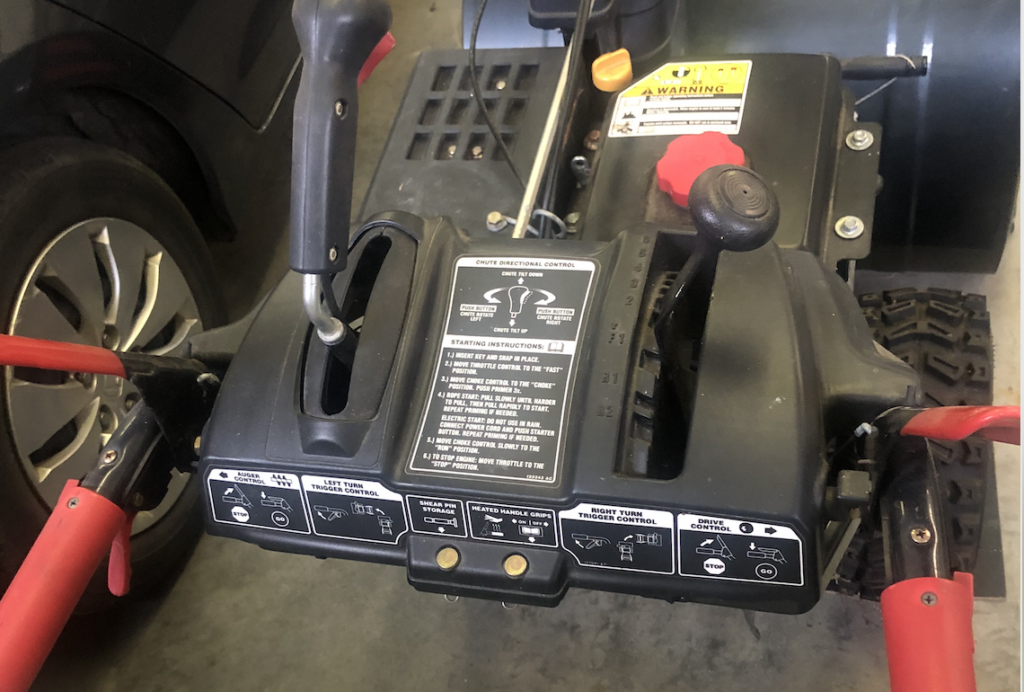If you own a Husqvarna snow blower, you know how important it is to keep your driveway and walkways clear during the cold winter months. However, what do you do if your Husqvarna snow blower won’t start?
Before you panic and reach for the phone to call a professional, there are a few common problems and solutions you can try on your own. Let’s dive into understanding your Husqvarna snow blower and the key components that make it work.
Understanding Your Husqvarna Snow Blower
Before we get into the specific problems and solutions, it’s essential to have a basic understanding of how your Husqvarna snow blower operates. Knowing the key components and how they work together will help you troubleshoot and fix common issues.
A Husqvarna snow blower is a powerful machine designed to clear snow from driveways, sidewalks, and other surfaces. It is equipped with various components that work in harmony to ensure efficient snow removal.

Key Components of Husqvarna Snow Blower
Your Husqvarna snow blower consists of several essential components, including the engine, fuel system, spark plug, and carburetor. Each component plays a vital role in the overall functioning of the machine.
The engine is the heart of your snow blower, responsible for powering the machine and driving the snow-throwing mechanism. It is typically a four-stroke engine, which means it completes four separate strokes to complete one operating cycle. These strokes include intake, compression, combustion, and exhaust, each serving a specific purpose in the engine’s operation.
The fuel system is responsible for delivering the necessary fuel to the engine. It consists of a gas tank, fuel lines, and a fuel pump or carburetor. The fuel tank stores the gasoline, while the fuel lines transport it to the carburetor or fuel pump. The carburetor is a crucial component that mixes the fuel with air to create a combustible mixture that can be ignited by the spark plug.
The spark plug is an essential part of the ignition system. It creates a spark that ignites the fuel-air mixture in the combustion chamber, initiating the combustion process. A properly functioning spark plug is crucial for the engine to start and run smoothly.
The carburetor plays a critical role in ensuring the engine runs smoothly and efficiently. It regulates the fuel-air mixture entering the combustion chamber, adjusting it based on the engine’s needs. A well-tuned carburetor ensures optimal performance and fuel efficiency.
How Your Snow Blower Works
When you start your Husqvarna snow blower, fuel is drawn from the gas tank through the fuel system into the carburetor. The fuel lines transport the gasoline, and the carburetor mixes it with air to create a combustible mixture.
Once the combustible mixture is ready, the spark plug generates a spark that ignites the mixture in the combustion chamber. This combustion process generates power, which is transmitted to the impeller. The impeller is a rotating component that propels the snow out of the chute, effectively clearing your desired area.
It’s important to note that different models of Husqvarna snow blowers may have additional features or variations in their components. However, the basic principles of operation remain the same.
Understanding how your Husqvarna snow blower works and familiarizing yourself with its key components will empower you to troubleshoot and address any issues that may arise. Regular maintenance and proper care will ensure that your snow blower performs optimally, keeping your pathways clear during the winter season.
Problem 1: Fuel Issues
One of the most common reasons for a Husqvarna snow blower not starting is fuel-related problems. If your snow blower has been sitting for an extended period or you didn’t properly store it during the off-season, the fuel may have gone bad and become ineffective.
Identifying Fuel Problems
There are a few signs that can indicate fuel issues with your snow blower. If you notice a strong smell of gasoline, visible fuel leaks, or difficulty starting the engine, it’s likely that your snow blower is experiencing fuel problems. In some cases, the fuel may have become contaminated with debris or water.
When the snow blower is not in use for a long time, the fuel inside the tank can deteriorate. This happens due to the exposure to air and the chemical reactions that occur over time. The fuel loses its volatility, making it difficult for the engine to ignite. Additionally, if the snow blower was not stored properly during the off-season, moisture can seep into the fuel tank, causing further issues.
A strong smell of gasoline is a clear indication of fuel leakage. This can occur due to a damaged fuel line or a faulty fuel tank cap. Fuel leaks not only affect the performance of the snow blower but also pose a safety hazard. It is important to address this issue promptly to prevent any accidents or damage.
Solutions for Fuel-Related Issues
If you suspect that your snow blower’s fuel is causing the starting problem, the first step is to drain the old fuel from the tank and replace it with fresh fuel. It’s important to use the correct fuel mixture recommended by Husqvarna for your specific snow blower model.
When draining the old fuel, it is advisable to use a fuel siphon or a fuel pump to ensure a clean and efficient process. This will help remove any debris or contaminants that may have accumulated in the tank. Once the old fuel is drained, dispose of it properly according to local regulations.
After refilling the tank with fresh fuel, it is essential to check the fuel lines and filters for any clogs or damage. Over time, debris can accumulate in the fuel lines, obstructing the flow of fuel to the engine. Inspect the lines carefully and remove any blockages using a small brush or compressed air. If any fuel lines or filters are damaged, they should be replaced to ensure proper fuel flow.
Regular maintenance and proper storage of the snow blower during the off-season can help prevent fuel-related issues. It is recommended to use a fuel stabilizer when storing the snow blower for an extended period. This will help keep the fuel fresh and prevent it from deteriorating. Additionally, storing the snow blower in a dry and covered area will minimize the chances of moisture entering the fuel tank.
By addressing fuel-related issues promptly and following proper maintenance practices, you can ensure that your Husqvarna snow blower starts smoothly and performs optimally during the winter season.
Problem 2: Spark Plug Failure
The spark plug is a crucial component in the ignition process of your Husqvarna snow blower. If the spark plug is faulty or not functioning correctly, it can lead to starting problems.
Recognizing Spark Plug Issues
There are a few indications that your snow blower’s spark plug may be failing. You may experience difficulty starting the engine, erratic engine performance, or a complete lack of spark.
Resolving Spark Plug Failure
To resolve spark plug issues, start by removing the spark plug and inspecting it for signs of wear or damage, such as fouling or corrosion. If necessary, clean the spark plug or replace it with a new one. Be sure to use the correct spark plug recommended by Husqvarna for your particular snow blower model.
Problem 3: Carburetor Blockage
A blocked carburetor can prevent your Husqvarna snow blower from starting or running properly. Over time, debris, old fuel, or varnish can accumulate in the carburetor, obstructing the flow of fuel and air.
Detecting Carburetor Blockage
If your snow blower struggles to start, runs rough, or stalls during operation, it’s possible that your carburetor is blocked. Other signs of carburetor blockage include black smoke from the exhaust or an overly rich fuel mixture.
Clearing a Blocked Carburetor
To clear a blocked carburetor, start by removing and disassembling it according to the manufacturer’s instructions. Using a carburetor cleaner, carefully spray and clean all the components to remove any built-up debris or varnish. Pay close attention to the small passages and jets. Once cleaned, reassemble the carburetor and reinstall it on your snow blower.
Preventive Measures for Common Snow Blower Problems
While it’s natural for snow blowers to encounter issues over time, there are preventive measures you can take to minimize the occurrence of common problems.
Regular Maintenance Tips
Perform regular maintenance on your Husqvarna snow blower, such as changing the oil, inspecting the belts and pulleys, and lubricating moving parts. Following the manufacturer’s recommended maintenance schedule will help keep your snow blower in top-notch condition.
Pre-Winter Checks for Your Snow Blower
Before the winter season arrives, dedicate some time to perform pre-winter checks on your snow blower. Ensure the fuel is fresh and properly mixed, the spark plug is clean and in good condition, and all moving parts are well-lubricated. This proactive approach will ensure that your snow blower starts effortlessly when you need it the most.
In conclusion, if your Husqvarna snow blower won’t start, don’t panic. By understanding how your snow blower operates and troubleshooting common problems like fuel issues, spark plug failure, and carburetor blockage, you can often get your machine up and running again on your own. Remember to perform regular maintenance and pre-winter checks to prevent problems before they occur. With a little know-how and some basic troubleshooting skills, you’ll be able to keep your driveways and walkways clear all winter long.

